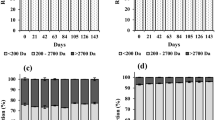Abstract
Probiotic beverage is one of the most recent developments in drink industry. The non-dairy drinks are popular all over the world. In this regard, the beverage containing Lactobacillus casei–containing rice bran extract and honey was examined. The effects of rice bran extract (0, 5, 10, and 15%) on the microbial, chemical, and sensory properties of probiotic beverage were investigated. The pH, acidity value, soluble solids content, cell viability, and sensory properties of samples were evaluated in 0, 7, 14, and 21 days of storage. The bacterial bioavailability decreased during refrigerator storage. The pH and soluble solid content of treatments decreased and the acidity value level increased significantly (P <0.05) during the storage. The results of sensory evaluation showed that the sample with 10% rice bran extract was more acceptable than others. Our findings considered using rice bran extract and honey for the production of beverage containing Lactobacillus casei as a valuable drink. Rice bran extract and honey along with probiotics would be an appropriate combination for making a unique drink in beverage industry.






Similar content being viewed by others
References
Fernandes CG, Sonawane SK, Arya SS (2018) Cereal based functional beverages: a review. J Microbiol Biotechnol Food Sci 198(3):914–919. https://doi.org/10.15414/jmbfs.2018-19.8.3.914-919
Verbeke W (2005) Consumer acceptance of functional foods: sociodemographic cognitive and attitudinal determinants. Food Qual Prefer 16(1):45–57. https://doi.org/10.1016/j.foodqual.2004.01.001
Szmigiel I, Suchodolski J, Łukaszewicz M et al (2019) The influence of Bacillus subtilis 87Y isolated from Eisenia fetida on the growth of pathogenic and probiotic microorganisms. Biomass Conv Bioref. https://doi.org/10.1007/s13399-019-00582-3
Heller KJ (2001) Probiotic bacteria in fermented foods: product characteristics and starter organisms. Am J Clin Nutr 73(2):34–39. https://doi.org/10.1093/ajcn/73.2.374s
Da Silva PMC, Gauche LV, Gonzaga AC, Oliveira Costa R (2015) Honey: chemical composition stability and authenticity. Food Chem 16:25–30. https://doi.org/10.1016/j.foodchem.2015.09.051
Alnaimat S, Wainwright R, Al’Abri MK (2012) Antibacterial potential of honey from different origins: a comparsion with manuka honey. J Microbiol Biotechnol Food Sci 1(5):1328–1338
Kamal MA, Klein P (2011) Determination of sugars in honey by liquid chromatography. Saudi J Biol Sci 118:17–21. https://doi.org/10.1016/j.sjbs.2010.09.003
Hesam F, Tarzi BG, Honarvar M et al (2020) Valorization of sugarcane bagasse to high value-added xylooligosaccharides and evaluation of their prebiotic function in a synbiotic pomegranate juice. Biomass Conv Bioref. https://doi.org/10.1007/s13399-020-01095-0
Reid G (2008) Probiotics and prebiotics – progress and challenges. Int Dairy J 18(10):969–975. https://doi.org/10.1016/j.idairyj.2007.11.025
Massoud R, Fadaei V, Khosravi-Darani K (2015) Improving the viability of probiotic bacteria in yoghurt by homogenization. J Food Process Preserv 39:2984–2990. https://doi.org/10.1111/jfpp.12551
Tripathi MK, Giri SK (2014) Probiotic functional foods: Survival of probiotics during processing and storage. J Funct Foods 9:225–241. https://doi.org/10.1016/j.jff.2014.04.030
Riane K, Sifour M, Ouled-Haddar H, Idoui T, Bounar S, Bousse S (2019) Probiotic properties and antioxidant efficiency of lactobacillus plantarum isolated from milk. J Microbiol Biotechnol Food Sci 20(3):516–520. https://doi.org/10.15414/jmbfs.2019/20516-520
Parvez S, Malik KA, Kang S, Kim HY (2006) Probiotics and their fermented food products are beneficial for health. J Appl Microbiol 100(6):1171–1185. https://doi.org/10.1111/j.1365-2672.2006.02963
Rice and human nutrition. Food and Agriculture Organization of the United Nations (FAO) (2020) http://www.fao.org/rice2004/en/fsheet/factsheet3.pdf. Accessed 11 Apr 2020
Begum A, Sarma J, Borah P, Moni Bhuyan P, Saikia R, Hussain Ahmed T, Rai L (2015) Microwave (MW) energy in enzyme deactivation: stabilization of rice bran from few widely consumed indigenous rice cultivars (Oryza sativa L.) from Eastern Himalayan range. Curr Nutr Food Sci 11:240–245. https://doi.org/10.2174/1573401311666150521233113
Limtrakul P, Semmarath W, Mapoung S (2019) Anthocyanins and proanthocyanidins. IntechOpen https://www.intechopencom/books/phytochemicals-in-human-health/anthocyanins and proanthocyani dins-in-natural-pigmented-rice-and-theirbioactivities. Accessed 11 Apr 2020
Fraterrigo Garofalo S, Tommasi T, Fino D (2020) A short review of green extraction technologies for rice bran oil. Biomass Conv Bioref. https://doi.org/10.1007/s13399-020-00846-3
Gula K, Yousu B, Singh AK, Singh P, Wanidef AA (2015) Rice bran: nutritional values and its emerging potential for development of functional food-a review. Bioact Carbohydr Diet Fibre 6(1):24–30. https://doi.org/10.1016/j.bcdf.2015.06.002
Meedam A, Usaku C, Daisuk P et al (2020) Comparative study on physicochemical hydrolysis methods for glycerides removal from rice bran acid oil for subsequent γ-oryzanol recovery. Biomass Conv Bioref. https://doi.org/10.1007/s13399-020-00775-1
Perera AA, Gunathilake KGT, Manawadu TC (2017) Market analysis for rice bran milk: a study of consumer preference towards alternative dairy beverages in Sri Lanka. J Res Market 8(1):22–45
Gupta M, Bajaj BK (2017) Development of fermented oat flour beverage as a potential probiotic vehicle. Food Biosci 20(1):104–109. https://doi.org/10.1016/j.fbio.2017.08.007
Luiz-Freire A, Ramos CL, Schwan RF (2017) Effect of symbiotic interaction between a fructooligosaccharide and probiotic on the kinetic fermentation and chemical profile of maize blended rice beverages. Food Res Int 100(1):698–707. https://doi.org/10.1016/j.foodres.2017.07.070
Nematollahi A, Sohrabvandi S, Mortazavian AM, Jazaeri S (2016) Viability of probiotic bacteria and some chemical and sensory characteristics in cornelian cherry juice during cold storage. Electron J Biotechnol 21(1):49–53. https://doi.org/10.1016/j.ejbt.2016.03.001
Chotiko A, Sathivel S (2016) Development of a combined low-methoxyl-pectin and rice-bran-extract delivery system to improve the viability of Lactobacillus plantarum under acid and bile conditions. LWT Food Sci Technol 66(1):420–427. https://doi.org/10.1016/j.biortech.2010.02.062
Chemat F, Vian MA, Ravi HK et al (2019) Review of alternative solvents for green extraction of food and natural products: panorama principles applications and prospects. Molecules 24. https://doi.org/10.3390/molecules24163007
AOAC (2014) In Official Method of Analysis of AOAC Intl. 17th ed. Association of Official Analytical Communities Gaithersburg Maryland USA
Fan BF, Pérez-Díaz P (2017) Survival and growth of probiotic lactic acid bacteria in refrigerated pickle products. J Food Sci 82(1):167–173. https://doi.org/10.1111/1750-3841.13579
Guergoletto K, Magnani M, San Martin J, Andrade C, Garcia S (2010) Survival of Lactobacillus casei (LC1) adhered to prebiotic vegetal fibers. Innov Food Sci Emerg Technol 11l:415–421. https://doi.org/10.1016/j.ifset.2009.11.003
Pereira ALF, Almeida FDL, Jesus AL, Costa JM, Rodrigues S (2013) Storage stability and acceptance of probiotic beverage from cashew apple juice. Food Bioprocess Technol 6(11):3155–3165. https://doi.org/10.1007/s11947-012-1032-1
Sadaghdar M, Mortazavian M (2012) Survivaland activity of five probiotic lactobacilli strains in two types of flavored fermented milk. Food Sci Biotechnol 1(1):151–157. https://doi.org/10.1007/s10068-012-0019-z
Cheung J, Huang G, Yu X (2010) Microbial-growth inhibition during composting of food waste: effects of organic acids. Bioresour Technol 101(1):5925–5934. https://doi.org/10.1016/j.biortech.2010.02.062
Lind A, Jonsson H, Schnurer S (2005) Antifungal effect of dairy propionibacteria-contribution of organic acids. Int J Food Microbiol 98(1):157–165. https://doi.org/10.1016/j.ijfoodmicro.2004.05.020
Wzorek SB, Koskowska A (2003) Attempt to obtain beverage containing viable lactic acid bacteria and estimation of their survival ability at the selected temperature. Acta Sci Pol Technol Aliment 2(2):47–56 http://www.food.actapol.net/issue2/volume/522003.pdf
Kailasapathy A (2006) Survival of free and encapsulated probioyicbacteria and their effect on the sensory properties of yogurt. LWT - Food Sc Technol 39:1221–1227. https://doi.org/10.1016/j.lwt.2005.07.013
Cyzowska AE, Klewicka Z, Libudzisz R (2006) The influence of lactic acid fermentation process of red beet juice on the stability of biologically active colorants. Eur Food Res Technol 223:110–116. https://doi.org/10.1007/s00217-005-0159-y
Yoon KY, Woodams EE, Hang YD (2005) Fermentation of beet juice by beneficial lactic acid bacteria. LWT Food Sci Technol 38:73–75. https://doi.org/10.1016/j.lwt.2004.04.008
Kun S, Rezessy-szabó JM, Nguyen QD, Hoschke A (2008) Changes of microbial population and some components in carrot juice during fermentation with selected Bifidobacterium strains. Process Biochem 43:816–821. https://doi.org/10.1016/j.procbio.2008.03.008
Baccouche A, Ennouri M, Felfoul I, Attia H (2013) A physical stability study of whey-based prickly pear beverages. Food Hydrocoll 33(2):234–244. https://doi.org/10.1016/j.foodhyd.2013.03.007
Jaworska A, Pogoń K, Gwóżdź E (2014) Quality changes of blackcurrant nectar under different storage conditions. J Life Sci Res 1(1):16–20
Lupien-Meilleura J, Roya D, Lagacéb L (2016) Viability of probiotic bacteria in a maple sap beverage during refrigerated storage. LWT Food Sci Technol 74(1):160–167. https://doi.org/10.1016/j.biortech.2010.05.053
Author information
Authors and Affiliations
Corresponding author
Ethics declarations
Conflict of interest
The authors declare no competing interests.
Additional information
Publisher’s note
Springer Nature remains neutral with regard to jurisdictional claims in published maps and institutional affiliations.
Rights and permissions
About this article
Cite this article
Hatami, S., Tajabadi, N., Massoud, R. et al. Chemical and sensorial properties of probiotic beverage based on rice bran extract and honey. Biomass Conv. Bioref. 13, 5151–5156 (2023). https://doi.org/10.1007/s13399-021-01500-2
Received:
Revised:
Accepted:
Published:
Issue Date:
DOI: https://doi.org/10.1007/s13399-021-01500-2




